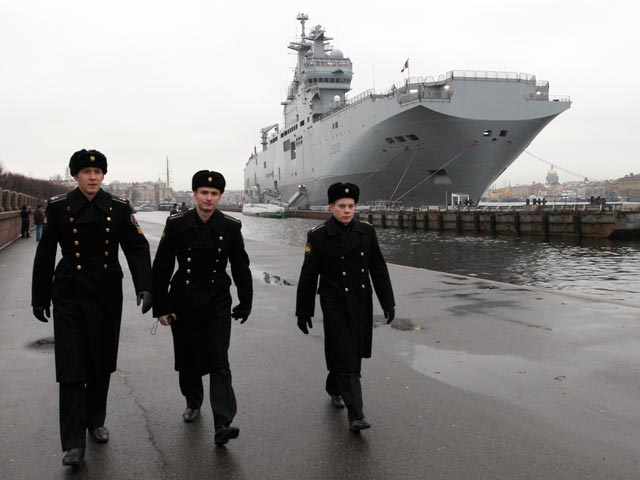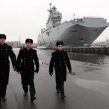
As Confrontation With US Worsens, Moscow Hopes to Make Inroads Into Europe
Publication: Eurasia Daily Monitor Volume: 11 Issue: 193
By:

The first of the two French-made helicopter-carrying Mistral-class assault ships, which Russia ordered in 2011, is reportedly ready for delivery. Deputy Prime Minister Dmitry Rogozin announced that a Russian official delegation has been invited to arrive on November 14, at the Saint-Nazaire shipyard for a handing-over ceremony—a claim that the French government flatly denied on October 30 (RTL, October 30). According to Rogozin, the final decision on the delivery of the Mistral-class “Vladivostok” must be made by French president Francois Hollande, but “we believe France must defend its reputation as a reliable arms supplier and fulfill the signed contract.” Rogozin added: “If the French fail to deliver the Vladivostok, using the Ukrainian crisis as a pretext, they are liable to pay multi-billion [dollar] damages” (Interfax, October 29). Last July, over 400 Russian naval personnel and specialists arrived in Saint-Nazaire to prepare to take over full control of the vessel. And on September 12, some 200 Russian sailors left Saint-Nazaire on board the Vladivostok on a ten-day training voyage. The second Mistral-class ship—the Sevastopol—is still under construction (Interfax, September 13).
After leaving Saint-Nazaire, the Vladivostok reportedly will sail to a St. Petersburg shipyard to be equipped with weapons. The Russian navy plans to have it fully operational by next year (Interfax, July 28). The main assault weapon of the Vladivostok will be 16 newly built Ka-52K armored helicopter gunships. The Vladivostok can also carry a reinforced marine battalion with armor and has modern French-provided communication equipment to deploy a combined-forces operational staff of up to 200 personnel (Rossyskaya Gazeta, June 24).
Originally, the Russian defense ministry insisted the Mistral-class ships Vladivostok and Sevastopol would be deployed in the Far East (in Vladivostok port) as part of the Russian Pacific Fleet. But after the annexation of Crimea last March, as the Ukrainian crisis unfolded, the commander of the Russian Black Sea Fleet, Admiral Alexander Vitko, and the chair of the Duma defense committee, former Black Sea Fleet commander Admiral (ret.) Vladimir Komoyedov, announced the possibility of the assault ships being deployed in the Black Sea—in Sevastopol or Novorossiysk. In the Black Sea, the Mistral-class ships could find more suitable targets for land-sea-air assaults than in the Pacific; furthermore, Black Sea waters are warmer and thus more conducive to operating the French-designed ships (RIA Novosti, May 30).
If the delivery of the Vladivostok goes ahead in mid-November, as Rogozin claims, by next spring or early summer, the assault ship may be leading the Black Sea Fleet in a sea-land-air operation to take control of Odesa or Nikolayev—the most important seaports left under Ukrainian control after the taking of Crimea. At present, a wobbly ceasefire still holds on the frontline in Donbas in eastern Ukraine, and a massive offensive operation by any of the warring parties seems unlikely during the coming winter. As good weather returns to the region next year, however, the ceasefire may fully collapse and the French-built Vladivostok may turn into a decisive military asset. The elections to the Ukrainian Rada (parliament) on October 26, produced a solid pro-Western majority, and the Kremlin may decide to abandon attempts to sway Ukrainian President Petro Poroshenko into a “compromise to federalize Ukraine,” which would transform the country into a loose confederation under de facto Russian control and protection. Instead, the Kremlin may choose to fully dismantle Ukraine, taking control of Russian-speaking regions like Odesa (Expert, October 29).
Speaking last week to select Western and Russian journalists and political scientists in Sochi at an annual meeting of the Valdai Club, President Vladimir Putin was blunt: The United States has totally failed as a world leader, and international chaos is rising. A new world order, curtailing US destructive influence, must be established or there will be wars. “If not a global war, then a string of intense local conflicts,” he asserted. Moscow’s interests and its domain, which apparently includes Ukraine, must be recognized, Putin added: “The bear will not take orders from anyone; the bear does not intend to move into other climatic zones, but his domain—the taiga—he will not give up” (kremlin.ru, October 24).
While denouncing failed US leadership, Putin is distinctly offering Europeans a choice. And for Hollande, that choice comes in mid-November: to hand over the Vladivostok, understanding that it may be used against Ukraine in 2015, or face the consequences of an open quarrel. According to a Russian foreign ministry source: “France is more interested in providing us with the ship, than we are in receiving it” (RIA Novosti, October 27).
Moscow seems to be offering European countries the old Cold War option of so-called “Finlandization”—allowing the Russian “bear” to own its domain unchallenged, while making good money trading European know-how and luxury goods for Russian oil and gas. The alternative is a steadily escalating level of regional confrontation. This week (October 29), at a joint meeting in Minsk of Russian and Belarusian top brass, Russia’s defense minister, Army-General Sergei Shoigu, announced: “The ‘colored revolution’ instrument of external intervention was used in Ukraine—the US and EU [European Union] provoked the overthrow of the legitimate president [Viktor Yanukovych] and are unquestionably supporting the armed suppression of discontent by the new authorities in Kyiv. In fact, pro-Western forces are attempting to form in Ukraine a forward bulwark to pressure the Union State of Russia and Belarus and prevent their sustained development. It is important to maintain battle-ready forces and coordinate measures to counter threats” (RIA Novosti, October 29).
The North Atlantic Treaty Organization’s (NATO) command has been reporting drastically increased activity of the Russian air force over the Atlantic, the Baltic and Norwegian Sea. Russian bombers and fighter jets fly over international waters, but often quite close to territorial airspace. NATO jets are being continually scrambled to intercept (Interfax, October 29). This activity seems to be out of the same Cold War textbook as Finlandization: It is known in Russian as “balancing on the verge of war” (balansirovat na grani voyni), or “brinkmanship” in English. The Kremlin is ready to scare the supposedly self-indulgent Europeans—who are reluctant to face real threats or increased defense spending—into backing out of an escalating standoff with the nuclear-armed Russia over Ukraine, which, according to Putin, is a synthetic nation constructed by Soviet Communist leaders (kremlin.ru, October 24). Moscow seems intent on preventing Ukraine from floating westward, away from “the bear’s taiga” domain, and is deliberately sending a signal: Russia will do what it takes (including war or threat of war) to prevent this outcome.




